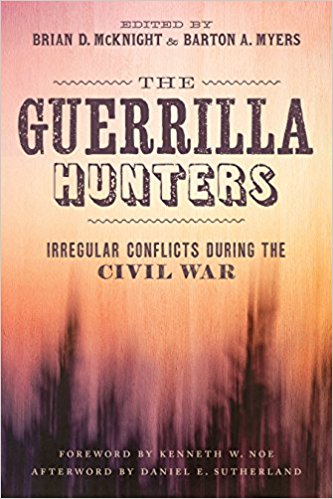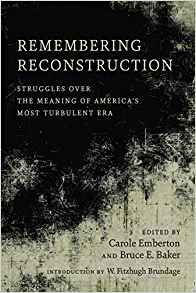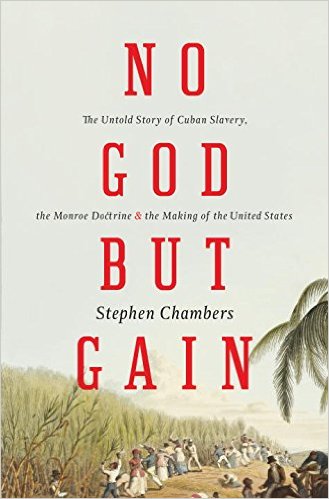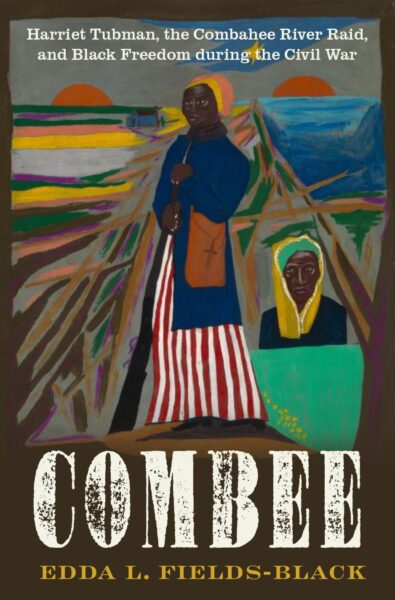The Guerrilla Hunters: Irregular Conflicts During the Civil War edited by Brian D. McKnight & Barton A. Myers. Louisiana State University Press, 2017. Cloth, ISBN: 978-0807164976. $49.95.
 Brian D. McKnight and Barton A. Myers, in partnership with the Louisiana State University Press, have assembled a valuable set of essays on irregular warfare during the Civil War. The essays in The Guerrilla Hunters cover both guerrilla organizations and counterinsurgency operations. McKnight and Myers identify five arguments that unite the essays: there was no single irregular war; Lost Cause mythologizers buried the story of guerrilla conflict in favor of a unified Confederacy; historians neglect guerrilla operations in favor of conventional battlefield narratives; even Confederate leaders did not comprehend the beast they unleashed by sanctioning guerrilla operations; and emphasis on irregular warfare introduces chaos to an otherwise neat narrative (4-5). This volume deserves to be read along with Daniel Sutherland’s A Savage Conflict. While Sutherland’s thesis—that guerilla operations were “decisive” to the war’s outcome—was overblown, the contributors to The Guerrilla Hunters add breadth and depth to the everyday reality of the war as lived by many combatants and civilians residing in the Border States, a war that for them was much less than “civil.” If guerrillas never decisively affected a major conventional battle or campaign, they certainly damaged military supply lines, intimidated Unionist civilians, and aggravated conventional commanders like William T. Sherman.
Brian D. McKnight and Barton A. Myers, in partnership with the Louisiana State University Press, have assembled a valuable set of essays on irregular warfare during the Civil War. The essays in The Guerrilla Hunters cover both guerrilla organizations and counterinsurgency operations. McKnight and Myers identify five arguments that unite the essays: there was no single irregular war; Lost Cause mythologizers buried the story of guerrilla conflict in favor of a unified Confederacy; historians neglect guerrilla operations in favor of conventional battlefield narratives; even Confederate leaders did not comprehend the beast they unleashed by sanctioning guerrilla operations; and emphasis on irregular warfare introduces chaos to an otherwise neat narrative (4-5). This volume deserves to be read along with Daniel Sutherland’s A Savage Conflict. While Sutherland’s thesis—that guerilla operations were “decisive” to the war’s outcome—was overblown, the contributors to The Guerrilla Hunters add breadth and depth to the everyday reality of the war as lived by many combatants and civilians residing in the Border States, a war that for them was much less than “civil.” If guerrillas never decisively affected a major conventional battle or campaign, they certainly damaged military supply lines, intimidated Unionist civilians, and aggravated conventional commanders like William T. Sherman.
I am struck by the unintended consequences of guerrilla warfare as sanctioned by the Confederacy that emerge in these essays, not least by those who volunteered to wage unconventional warfare. In discussing a minister who proposed to disrupt Union control of the Mississippi River by assassinating gunboat pilots, co-editor Barton Myers noted that many potential guerrillas “were quite willing to put aside peacetime beliefs and use deceptive tactics that might later endanger Confederate civilians” (27). Stephen Rockenbach notes that from late 1864, pro-Confederate guerrillas in Kentucky began killing discharged Union soldiers and members of the state militia to intimidate civilians away from overt support of the Union in a state no longer contested by conventional armies. An unintended consequence of these murders of “Lincolnites” was the summary execution of rebel guerrillas by Union forces engaged in counterinsurgent operations following Lincoln’s reelection. Brian Steel Wills analyzes the contested nature of Nathan Bedford Forrest’s status as a regular soldier or a guerrilla in commanding mounted forces in the western Confederacy, arguing that Forrest was and saw himself a regular soldier. Forrest—who claimed to never knowingly insult or mistreat Union prisoners—refused to see black soldiers as legitimate combatants, and, as seen most egregiously at Fort Pillow, treated them as “captured property, and not as captured soldiers” (65). This holds true regardless of whether Forrest himself was guilty of actively ordering or turning a blind eye to the murder of surrendering black and white Union soldiers on the banks of the Mississippi on April 12, 1864. Forrest took pains to order that black prisoners be sent back into slavery, with particular attention paid to returning them to their erstwhile masters. In this, Forrest aligned with leaders like Jefferson Davis, who resisted treating black soldiers in Union service as legitimate combatants eligible for prisoner of war status. Their refusal not only led to the breakdown in prisoner exchanges but also unintentionally increased race-based violence on conventional battlefields and guerrilla skirmish sites alike.
Whether hybrid guerrilla-soldiers like Forrest, soldier-politicians like Davis, or slaveholding guerrillas like Champ Ferguson, guerrillas and the Confederate leaders who sanctioned their operations acted to preserve slavery as a key component of the Confederate nation. In this objective, Confederate irregulars shared a crucial goal with conventional rebel field forces. A final unintended consequence of this racial ideology was that by sowing to the wind of secession and civil war to preserve slavery, guerrillas reaped the whirlwind of slave efforts to eradicate them even as they sought freedom. As Daniel Sutherland notes in the Afterword, while rebel insurgents intimidated slaves who resisted the Confederate regime, the enslaved made this conflict a two-way street by informing Union forces of guerrilla activities, facilitating the hunting down of guerrilla bands. And from 1863, thousands of former slaves took an active part in counterinsurgent operations as Union soldiers themselves. New studies of guerrilla conflict during the conflict only reinforce the indivisible relationship between slavery and the Civil War.
While most of the essays provide intriguing new insights via previously underutilized manuscript sources and novel arguments concerning nineteenth-century guerrilla warfare, they are not uniformly of high quality. A piece on whiskey and masculinity in Missouri began promisingly enough, but eventually loses credibility by its reliance on tautological arguments. Heavy alcohol use may well impair judgment, but it does not render deadly force inevitable in guerrilla operations. Missouri bushwhackers did not have to kill in any and every operation, even if one accepts the soldier-guerrilla hybrid General Forrest’s comment that “war means fighting and fighting means killing.” Alcohol may make it easier to pull the trigger to end the life of or maim another person, but it does not excuse individual volition or collective actions such as the Centralia massacre. The guerrillas who—however liquored up—fired the bullets certainly did not have “no alternative” (253) but to kill their fellow white Americans. The author argues that by “that point in the war,” late September 1864, “guerrillas were not taking prisoners” (252), which, if plausible for Missouri, was certainly not the always case in other theaters. This returns the reader to the editors’ first and fifth major points: that guerrillas operated and thought locally, and should be understood as such—replacing the “neat, clear narrative” (5) that readers prefer with the chaos that these historians find to be the reality of civil wars.
John H. Matsui is Assistant Professor of History at Virginia Military Institute and the author of The First Republican Army: The Army of Virginia and the Radicalization of the Civil War (2016).




